英语教学法课件
英语教学法教程(课堂PPT)

Method (the listen and repeat drills)
– Language is learned by constant repetition and reinforcement of the teacher
– Mistakes were immediately corrected
对语言教学本质的理解及其对教学实践的影响
9
Views on Lanuage
• The Structural View (结构主义) • The functional View(功能主义) • The interactional View(相互作用理论或交
互理论)
10
The Structural View
•
words
•
morphemes(词素)
• (the smallest meaningful unit)
•
phonemes(音素,音位)
• (the smallest unit)
13
The purpose of language learning
• To learn a language means to learn these structural items so as to be able to understand and produce language.
英语教学法教程全册配套PPT教学课件
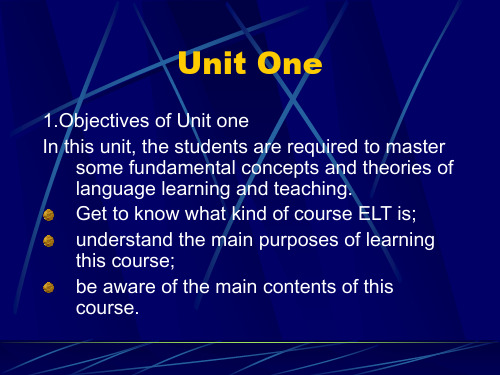
a. To provide learners with some current but basic theories related to language, language learning and language teaching.
b. To help learners develop practical skills and techniques in teaching the language.
e. To help learners develop their own ideas about ELT and the awareness of putting these ideas in their own teaching practice in the future.
3. What do you expect to learn or what do you want to learn from this course?
Teaching is a personal activity, and it is not surprising that individual teachers bring to teaching very different beliefs and assumptions about what constitutes effective teaching.
Howatt, A. P. R. A History of English Language Teaching. 上海:上海外语教育出版社, 1999.
Johnson, K. An Introduction to Foreign Language Learning and Teaching. 北京:外语教学与研究出版社, 2002.
英语教学法之Direct--Method(直接法)PPT优秀课件
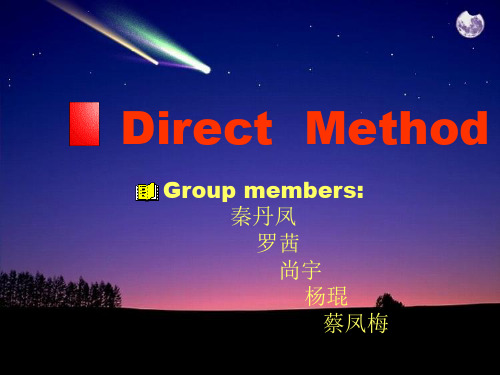
2.2 Possibility:
The rapid development of linguistics, psychology and education provided the theoretical basis for the establishment of the Direct Method.
Direct Method
Group members: 秦丹凤 罗茜 尚宇 杨琨 蔡凤梅
1. Brief introduction of Direct Method
(1) Definition :The Direct Method is a method of foreign or second language teaching which insists that only the target language should be used in class, and meanings should be communicated “directly” by associating speech forms with actions, objects, mime, gestures, and situations.
7
enius ‘s idea ① education should be in line with nature, which justified the views on language teaching with the Direct Method. ②His “direct” principle , the principles of “from concrete to abstract, from near to far, from known to unknown, from simple to complex, from fact to conclusion” are put into practice in the Direct Method.
英语教学方法ppt课件
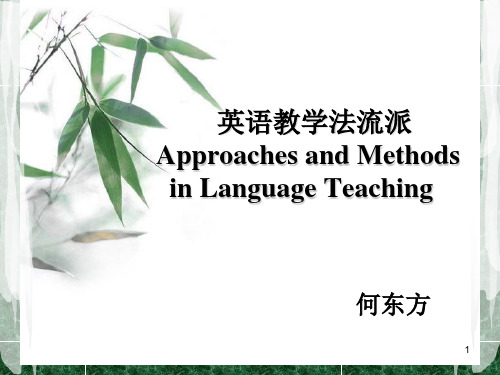
何东方
1
Review The Grammar-Translation Method
Definition: It means to translate from mother tongue to target language.That is to say,the method teaches foreign language with grammar explaination and translation exercise.
电子技术为核心的知识、技术技术密集型产业发展很快。 ➢ 听说法是20世纪40年代末在美国形成的外语教学法。二战期间,美国军
队进驻很多国家,军人急需掌握外语,特别是通过军队外语培训等教学 活动,创立了听说法。 ➢ 20世纪60年代末70年代初,随着另一门新兴学科社会语言学的诞生,社 会语言学家提出了“交际能力”的概念,在外语教学界引起了强烈的反 响,交际教学法学派随即迅速崛起。 ➢ 在交际法的带动下,20世纪70年代还兴起了人文主义教学法,主要包括 沉默法(the silent way)、提示法(suggestopedia)、社区式语言学习 (community language learning)和全身反应教学法(the total physical response method)等新型的外语教学法。这些教学法的共同特点是强调 学生是教学的主体。除了分析学生的需要和学习过程外,还注意学生学 习外语的心理特点,努力创造条件,排除学生学习外语时的心理障碍。 4
2
外语教学简史
一、500年前,
➢ 15世纪以前,在西欧、拉丁语处于主流地位,不仅用于日常口语
英语教学法课件 Unit 2 Part 2 Task-based Language Teaching(王蔷主编)
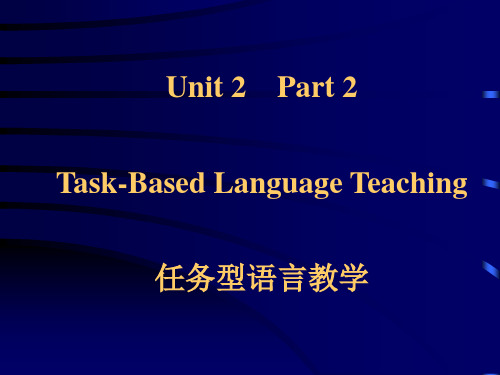
• “TBLT” has stressed the importance to combine form-focused teaching with communication focused teaching.
2. 1 What is a task? P27
A task is a piece of work undertaken for oneself or for others, freely or for some reward. It is meant what people do in everyday life, at work, at play, and in between. (Long 1985:89) 任务是人们在日常生活中所从事的有目的的活 任务是人们在日常生活中所从事的有目的的活 动。
Listening to a weather forecast and deciding what to wear Looking at a set of pictures and decide what should be done Responding to a party invitation Completing a banking application Describing a photograph of one’s family
3) Learner participation in class is related significantly to improvements in language proficiency. Lim (1992)
学习者积极主动的参与与语言熟练程度的提 高关系极大。 高关系极大。
4) Classrooms that were basically “communicative” for explicit grammatical instruction, were superior to both traditional classrooms that focused heavily on grammar, and to immersion programs that eschewed explicit grammatical instruction. 基本上以“交际”为导向的课堂教学, 基本上以“交际”为导向的课堂教学,但同时 也有明确的语法讲解, 也有明确的语法讲解,要比只注重语法教学或 回避语法讲解的沉浸式教学都更好。 回避语法讲解的沉浸式教学都更好。
外语教学法主要流派介绍ppt课件
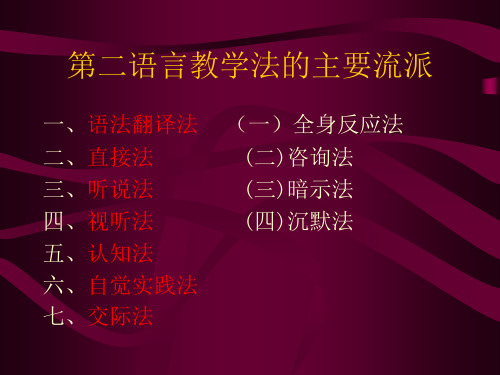
1、功能法产生的时代背景 威尔金斯《意念大纲》
( “Notional Syllabuses”,1978 )
2、功能法的理论基础 1)语言学理论基础 2)心理学理论基础
3、功能法的基本原则 1)以单元---学分体系组织语言教学 2)以功能意念为纲 考虑交际要素 3)教学过程交际化 4)基本目的语和专业目的语兼顾
日常交际 完整的交际活动 1、理论基础
1)语言习得理论 2)社会建构理念 3)课程理论
2、教学原则与特点 原则: 1)言语、情景真实性 2)形式---功能性 3)任务相依性 4)做中学 5)脚手架
特点: 1)目标 2)教师的输入 3)教学技巧与方式 4)教师角色 5)学生角色 6)评价方式与内容
第二语言教学法的主要流派
一、语法翻译法 二、直接法 三、听说法 四、视听法 五、认知法 六、自觉实践法 七、交际法
(一)全身反应法 (二)咨询法 (三)暗示法 (四)沉默法
一、语法翻译法
• 语法翻译法是以语法为基础用母语来教授外 语的一种方法
1、语法翻译法的理论基础 2、语法翻译法的教学原则
1)以语法教学为中心 强调系统语法的学习 2)语言材料的内容以突出某种语法形式为准 3)运用学生母语进行课堂教学 4)以阅读和书面翻译为主 3、对语法翻译法的评价
4、对自觉对比法的评价 附:自觉实践法
七、认知法(cognitive Approach)
• 按照认知规律 • 调动学生的智力潜能 • 努力发现和掌握语言规则 • 创造性地活用语言 • 一种外语教学法体系 • 又称为认知——符号学习理论
1、认知法产生的背景 2、认知法的理论基础 3roach) 1、视听法产生的时代背景 2、视听法的理论基础
1)语言学理论基础
【英语教学法课件】Unit1Languageandlanguagelearning

4. Howatt, A.P.R. A History of English Language Teaching第十.五页(,共《78页。 英语语言教学(jiāo
Audiolingualism
第二十五页,共78页。
听说法 (shuōf ǎ)
Audio-Lingual Method
❖ ‘Listen and repeat’ drilling activities are the most important classroom activities.
❖ Mistakes are immediately corrected and correct utterances are immediately praised.
❖ Functional view– communicative categories, communicative ability (to be able to communicate)
❖ Interactional view– to communicate appropriately (communicative strategies, cultural awareness, etc.)
❖ Language is a rule-based system and with a knowledge of the finite rules (language competence), infinite sentences can be produced
舒白梅英语教学法课件
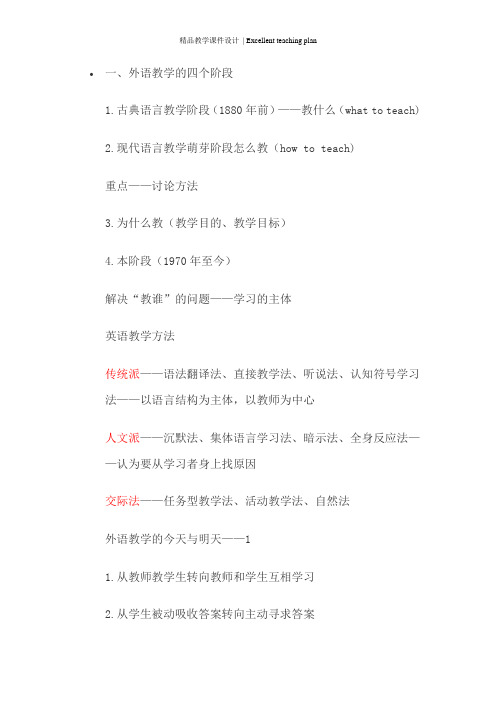
•一、外语教学的四个阶段1.古典语言教学阶段(1880年前)——教什么(what to teach)2.现代语言教学萌芽阶段怎么教(how to teach)重点——讨论方法3.为什么教(教学目的、教学目标)4.本阶段(1970年至今)解决“教谁”的问题——学习的主体英语教学方法传统派——语法翻译法、直接教学法、听说法、认知符号学习法——以语言结构为主体,以教师为中心人文派——沉默法、集体语言学习法、暗示法、全身反应法——认为要从学习者身上找原因交际法——任务型教学法、活动教学法、自然法外语教学的今天与明天——11.从教师教学生转向教师和学生互相学习2.从学生被动吸收答案转向主动寻求答案3.从师生严格执行教学计划转向师生灵活进行活动4.从以教师为主的课程设置向着有学生参与的集体课程设置转变5.从孤立、割裂的学科转向互相联系的跨学科内容6.从检测死记硬背书本知识转向评价学生应用所学分析问题、解决问题的能力7.从强调课本教学转向利用多种信息资源和生活经验补充书本8.从把学生看做由教师进行信息处理的接收器转向把他们看做与教师共同进步的伙伴9.教学环境发生变化:从教师做决定、期待学生去执行决定转向学生有权选择自己的学习内容和学习方式当代课程的发展趋势9.教学环境发生变化:•二、-----外语教学研究发展的趋势:(1)从语言学理论上讲,指导外语教学的语言学理论从结构主义转成了功能交际主义;(2)从心理学上讲,从行为主义心理学转到了认知心理学;(3)教学重点从注重语言形式到注意意义和功能;(4)教学模式从教师为中心到以学生为中心;(5)学习方式从被动学习到自主学习;(6)从评估方面看,原来强调客观测试,近十年强调主观测试;(7)授课方式从面授到多媒体的,甚至远距离的同步学习。
2------国际学术背景:2------国际学术背景:(1)研究对象从客体逐渐转向了主体——客体:语言、教材、教法、老师等;主体:学生(2)支持外语教学的理论从普通语言学一种发展到了多个学科;(各种语言学)(3)技能教学转向内容教学;(4)从劳动密集型教学到高科技密集型教学、从过程管理到目标管理;3------教师应处理好的六大关系之一:(六个矛盾)(1)知识与能力的关系;(讲不讲语法要看学生的需要,没有知识的能力是无源之水,把知识转化为能力,达到知识与能力的平衡)(2)教师与学生的关系(强调发挥学生能动性,老师的知道也很重要。
小学英语教学方法PPT教学课件

果能把内容相近、相反或相同的可比性
知识放在一起进行对照、比较,就能帮
助学生把类别性的知识“连接”起来,
使他们在头脑中有一个链条式的记忆锁,
提高小学生进行初步抽象概括思维的能
力。例如在教学Panda这个单词时,可
以就它与学过的器官eye的一个共同属
性———黑白颜色进行归纳总结。这样
教学将关键词Panda、Eye、Black、
过渡。又如在导入Stationeries时,可以
先用汉语告诉学生一个chant“铅笔盒里有
铅笔,铅笔里面有钢笔”,利用学生此
时产生的“?”疑惑感,如此在接下来
的教学中通过展示、教学这三个单词,
使学生恍然大悟,产生一种解疑后的喜
悦感和成就感。
2020/12/10
11
对比导入
对比导入,即是在教师讲授新课时,如
曲导入动物话题的教学;然后再把歌词
相应地替换成“Teddy Dog,Teddy
Rabbit…”达到在一个轻音乐缭绕的氛围
中导入一项教学内容的目的。
2020/12/10
10
悬念导入
恰当的悬念是一种兴奋剂。教师在教学
中给学生设下悬念,能勾起学生强烈的
破疑愿望,激起他们寻根探源的欲望,
从而促使学生迈过“信息沟”实现交际
2020/12/10
8
故事导入
就像每个单元的C部分设置了Story time,以巩
固本单元的内容一样。我们也可以大胆创新,
把它搬家移到一个教学单元的开头。例如对第 四单元的Animals的导入设计。在进行A部分教
学时,教师可以以一个农场主的身份介绍 “Look! I have a rabbit.”……同时还为后面 的song“Old MacDonald”做了铺垫;而在进行 B部分的导入时,教师又可以改扮成一个动物
英语教学法之直接法ppt课件

Background
• A reaction against the GrammarTranslation Method. • In the mid and late 19th century, European industry developed rapidly.
• The foundation of the IPA and other organizations.
Theoretical Basis
• Direct means takes the place of translation as the main technique in foreign language learning. • Speech patterns should be the fundamental elements of language.
2. Without explicit grammar explanantion, students lack a necessary knowledge of the target language.
3. The Direct Method places a high demand on teachers.
Basic Principles
• Main features:
1. The first language and translation exercises are completely avoided.
2. Grammar is learned inductively through listening and speaking activities (an explicit grammar rule may never be given).
小学英语教学法PPT课件

• 儿童的学习特点:
1) It's difficult for children to understand verbal instructions to begin with.
2) Children's attention span is very limited.(7-10y, 20mins;1012y,25mins;above 12y, 30mins)
• Recall a very successful English class. What made it successful?
• Discipline problem What are the causes?
• Error corБайду номын сангаасection
Example A • T: What's your name? • S: My name Tom. • T: Oh, good. Your name is Tom. • S:Yes, My name is Tom. • T: Hello, Tom.
• S: Yes, TALL. He's tall.
• T: Very good, Tom.
• When we correct pupils' errors, we have to remember the objectives of correction:
• building pupil's confidence • raising awareness • acknowledge achievement and progress • helping pupils to become more accurate in
《英语教学法》Unit 10 Teaching-Speaking课件

o 5 . Clarifying techniques
o 6 . Cultural and social knowledge
11
Teaching model of teaching speaking
o 3P model:
Presentation Practice Production
12
Characteristics of successful speaking tasks
time- constraint.
4
Common features of spoken language (Bygate, 1987)
o Using less complex syntax; o Taking short cuts, e.g. incomplete
sentences; o Using fixed conventional
language they know in order to get
meanings across as effectively as possible .
b. social interaction activities
- - purpose: Learners should pay greater
7 . Interactive model
7
Principles for teaching speaking
o 1 . Balancing accuracy- based with fluencybased practices
o 2 . Contextualising practice o 3 . Personalising practice o 4 . Building up confidence o 5 . Maximazing meaningful interactions o 6 . Helping Ss develop speaking strategies o 7 . Making the best use of classroom
英语教学法Unit6TeachingPronunciation课件

6.3 Aspects of pronunciation
❖ Sounds (48 phonemes: vowels, consonants)
❖ Phonetic symbols
❖ Phonetic rules ( eg. vowel alphabet, cluster of letters)
Some ideas about the goal of teaching pronunciation:
1. our goal is not to require Ss to have a native-like pronunciation due to 3 reasons:
❖ A. critical period (Benneberg 1967) ❖ B. the amount of exposure to English ❖ C. the physiological differences Can you think of some more reasons?
Tonguetwisr:Shla
1.上唇(upper lip) 2.下唇(lower lip) 3.上齿(upper teeth) 4.下齿(lower teeth) 5.齿龈(alveolar ridge) 6.硬腭(hard palate) 7.软腭(soft palate) 8.小舌(uvula) 9.舌尖(tip of the tongue) 10.舌前部(front of the
Which do you agree more?
❖ 1. Pronunciation is of great importance. If a child cannot learn correct pronunciation at the beginning, he/she will not learn correct English well.
- 1、下载文档前请自行甄别文档内容的完整性,平台不提供额外的编辑、内容补充、找答案等附加服务。
- 2、"仅部分预览"的文档,不可在线预览部分如存在完整性等问题,可反馈申请退款(可完整预览的文档不适用该条件!)。
- 3、如文档侵犯您的权益,请联系客服反馈,我们会尽快为您处理(人工客服工作时间:9:00-18:30)。
3.Learnability: The contents and tasks planned for the lesson should be within the learning capability of the students. Of course, things should not be too easy either. Doing things that are beyond or below the students'coping ability will diminish their motivation.
4.Linkage: The stages and the steps within each stage are planned in such a way that they are somehow linked with one another. Language learning needs recycling and reinforcement.
A.Macro Planning
In a sense, macro planning is not writing lesson plans for specific lesson but rather familiarizing with the context in which language teaching is taking place. Macro planning involves the following:
b.Practice
At the practice stage, the lesson moves from controlled practice to guided practice and further to the exploitation of the texts when necessary.
B.Another 3-stage Model
Pre-, while-and post-. E.G.It is frequently advised and adopted in reading lessons, that is, pre-reading while-reading and post- reading stages. This model is also often applied in listening lessons, which have pre-listening, while-listening and post-listening stages.
II.Macro Planning Vs. Micro Planning
Ideally, lesson planning should be done ay two levels: macro planning and micro planning. The former is planning over time, for instance, the planning for a month,a term, or the whole course. The latter is planning for a specific lesson, which usually lasts 40 or 50 minutes. Of course, there is no clear cut difference between these two types of planning. Micro planning should be based on macro planning, and macro planning is apt to be modified as lessons go on.
Hale Waihona Puke 1) Knowing about the course:
The teacher should get to know which language areas and language skills should be taught or practised in a course, what materials and teaching aids are available, and what methods and techniques can be used.
I.Principles for Good Lesson Planning
1.Variety: Planning a number of different types of activities and where possible introducing students to a wide selection of materials so that learning is always interesting, motivating and never monotonous for the students.
2) Three Teachers' Instructions to the Lesson:
Teacher A: Today we're going to learn Lesson 15. It's question and answer practice using a substitution table. Teacher B: Today we're going to practise present simple questions with "when…" and when other time expression. Teacher C: Today we're going to practise asking and answering questions using the present simple tense, so that we will learn how to talk about everyday activities.
Lesson 15
Ask and answer questions from the table.
get up eat breakfast wash your face When do you go to school finish school go to bed clean your teeth? meet your friends? When do you learn English? play games? in the morning in the afternoon in the evening at night
A.3P Model
a.Presentation b.Practice c.Production
a.Presentation
At the presentation stage, the teacher introduce new vocabulary and grammatical structures with reference to their contextualized use.
2) Knowing about the institution:
The teacher should get to know the institution's arrangements regarding time, length, frequency of lessons, physical conditions of classrooms, and exam requirements.
c.Production
At the production stage, the students are encouraged to use what they have learned and practised to perform communicative tasks. At this last stage, the focus is on meaning rather than formal accuracy.
Unit 3 Lesson Planning
Aims of the Unit
- to understand why lesson planning is necessary - learn the difference between macro planning and micro planning - to get to know the components of a lesson plan - to know the principles for good lesson planning
4) Knowing about the syllabus:
The teacher should be clear about the purposes, requirements and targets specified in the syllabus.
ponents of a Lesson Plan
3) Language Contents and Skills
language contents: structures (grammar), vocabulary, functions, topics and so on. Language skills: communicative skills involved in listening, speaking, reading and writing
2.Flexibility: Planning to use a number of different methods and techniques rather than being a slave to one methodology. This will make teaching and learning more effective and more efficient.
